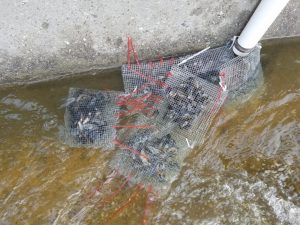SCCWRP begins documenting persistence of eDNA in stream environments

SCCWRP has completed a pilot study examining how long the environmental DNA signal of an organism lingers in a stream following the removal of the source organism, part of an effort to assess whether eDNA can be used to reliably document the species present in streams.
eDNA, which is the genetic material that organisms shed into their environment, has the potential to offer a rapid, cost-effective assessment of what species are living in a stream. It would be particularly useful for providing early warnings for the emergence of an invasive species, or for tracking endangered species.
The pilot study, completed in February, involved placing marine mussels into concrete-lined Coyote Creek in Orange County. Marine mussels are not naturally found in this freshwater environment.
The study found that the mussels’ eDNA signal was detectable at least 1.5 kilometers downstream of the site, but also that the signal quickly dissipated after the mussels were removed from the channel.
More news related to: Bioassessment, DNA Barcoding